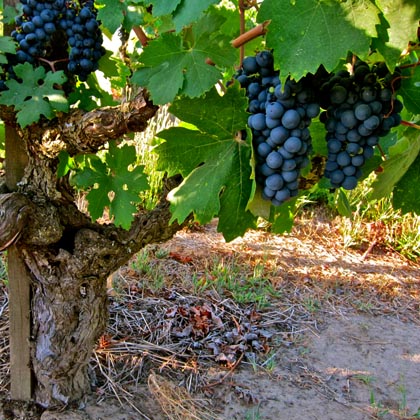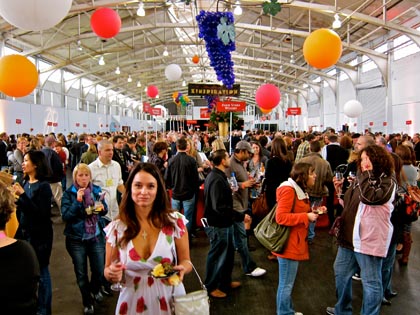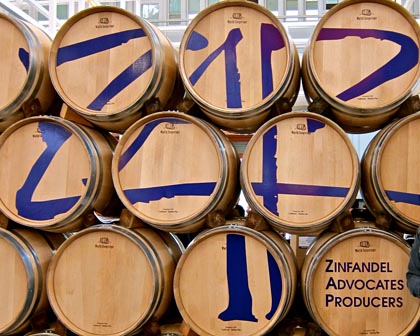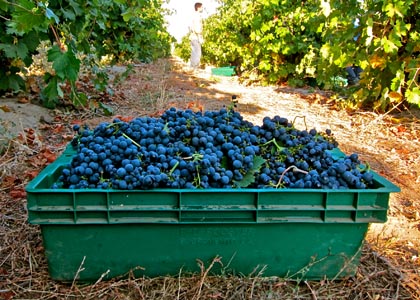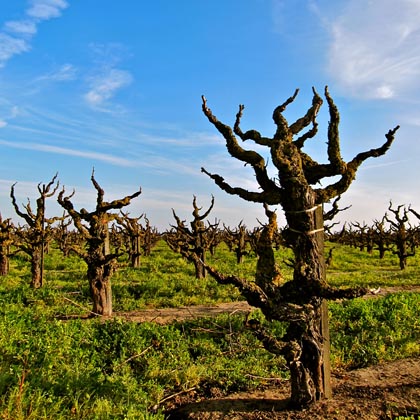Letters from Lodi
An insightful and objective look at viticulture and winemaking from the Lodi
Appellation and the growers and vintners behind these crafts. Told from the
perspective of multi-award winning wine journalist, Randy Caparoso.
In praise of ZAP & Lodi terroir
Ancient zin vine in Mohr-Fry Ranches -- one of Lodi's most beloved terroirs...
You don’t need flowers in your hair, just an enthusiasm for a wine grape that was once so well loved that it was nearly forgotten. Each year for over the past twenty years, some 7,000 to 8,000 Zinfandel lovers have flocked to San Francisco for Zinfandel Advocates & Producers’ annual Grand Tasting. Clearly, if there is any one grape that personifies vinous love and power-to-the-people, Zinfandel is it.
This year’s ZAP Grand Tasting takes place on January 28, 2012 at The Concourse (8th & Brannan) in San Francisco, where over 250 wineries will be pouring their Zinfandels – including these Lodi based producers:
Brazin Wines
Cycles Gladiator
Gnarly Head Wines
Harney Lane Winery
Ironstone Vineyards
Klinker Brick Winery
LangeTwins Family Winery & Vineyards
m2 Wines
Macchia Wines
McCay Cellars
Michael-David Winery
Spenker Winery
St. Amant Winery
The Lucas Winery
Van Ruiten Family Winery
If you’re planning to attend this vinous bash, what should you look for? Recently we received a note from a newly formed group called Terra Lodi (re their Facebook page), whose self stated mission is to highlight and promote the types of winemakers and growers who craft wines of exceptional quality and a true “sense of place.” In other words, terroir – in the classic French parlance.
Zin lovers at the 2011 ZAP Grand Tasting
What is terroir, and why should it matter to a Lodi Zinfandel lover? From a classicist’s perspective, expression of terroir is just as important as “varietal character” in a good Zinfandel because it helps us appreciate diversity that comes from a vineyard rather than the sameness of varietal expectations. For folks behind Terra Lodi, it’s a way of highlighting what makes the Lodi American Viticultural Area a special winegrowing region – especially for Zinfandel, and especially because Lodi is the source of the most extensive acreage of pre-sixties Zinfandel plantings in the state (in fact, over 40% of California’s Zinfandel is grown in Lodi).
Yes, it is true: the old French expression goût de terroir – or “taste of terroir” – is one of those wine qualities that most people, even many wine professionals and so-called “experts,” have trouble distinguishing in wines; and so the most convenient thing for many of them to do is to deny it exists, or that it matters. Especially when it comes to wines like Zinfandel, which often taste so strongly of the grape that qualities derived from geographic origins become neither here nor there.
But is this being fair to the grape? For many wine lovers, Zinfandel is as noble as Cabernet Sauvignon, Pinot Noir, or any variety belonging to Vitis vinifera, the original European family of fine wine grapes. Like Cabernet and Pinot Noir, Zinfandel makes unique and terrific tasting wines; and as such, far too good to be judged strictly in terms of how well it tastes of the grape. To Terra Lodi, a Lodi Zinfandel should also taste of Lodi: specifically, the full range of lush yet balanced, buoyant qualities yielded by vines planted in the region’s deep Tokay sandy loam and mild, steady (rarely too hot, and rarely too cold) Mediterranean climate.
That terroir is part and parcel of wines from France, for instance, is never questioned by the cognoscente. Fine French wines – the sort qualifying for specific appellation d’origine labels (rather than mass production ordinaire) – invariably do have a strong “sense of place,” which is essentially what terroir means: sensory qualities, including aromas and flavors, that can be attributed directly to where a wine is grown (soil and topography, climate, the grapes utilized, and even the human influences associated with viticultural and vinification practices in a given place of origin).
The problem with ignoring terroir and appreciating Zinfandel only in terms of varietal character is that this approach is an affront to what truly makes wine special: something that is grown and then crafted, not manufactured or churned out in monotonous droves. When we relegate the best Zinfandels to narrowly defined varietal fruit qualities, we are placing more value on how well a wine ascribes to preconceived notions rather than on how it might surprise or regale us with distinct qualities of its own.
Put it another way: if you truly love Zinfandel, you appreciate what makes each bottling unique, not the same. Otherwise, why drink, say, a Zinfandel by Macchia, Harney Lane or m2 when you can get everything you want in a McCay? McCay may make as good or better a Zinfandel as any Lodi producer, but real Zinfandel lovers don’t measure the value of a Zinfandel simply on the basis of an arbitrary conception of what makes for a “correct” Zinfandel. They look for diversity rather than the same ol’ same ol’: sensory qualities tied directly to terroir related distinctions.
Real Zinfandel lovers, in fact, often end up being completely oblivious to the notion that Zinfandel “quality” can be expressed in terms of 100 point scores or any other measurement of varietal scaling. They are interested in the growing and crafting good wine, not homogenized bottlings that meet the dubious or arbitrary standards of some wine publication. But sometimes, man, you can’t tell a stranger about rock ‘n roll, and that’s too bad: more and more zin lovers could give a damn about how this or that critic is “rating” a Zinfandel. They want zins that taste good, not those reflecting somebody else’s “good taste.”
2011 pickings in McCay's "Truluck's" vineyard...
Finally, there is the fact that many (but not necessarily all) of Lodi’s finest Zinfandels come from some California’s oldest vines, planted as long ago as the 1890s. Vines that are over 50 or 100 years old don’t survive unless they are well loved, and so you don’t need to know exactly how to explicate the taste of terroir in wines made from these plantings to appreciate that significance. All it takes is knowing that the finest California Zinfandels are best appreciated for where they are grown, in the exact same way we appreciate all the finest wines of the world.
In a great Zinfandel – whether it comes from Lodi, the Foothills, Contra Costa, Napa or Sonoma, Paso Robles or any other place where this noble grape has been lovingly cultivated – sense of terroir is always there. Even if you can’t make out the sensory distinctions, it’s there in the quality, which is certainly in the case of Zinfandels sourced from Lodi’s historic plantings, which have endured precisely for that reason…
Hope to see you at ZAP!
50 year old Lodi zin vines in a January morning...
